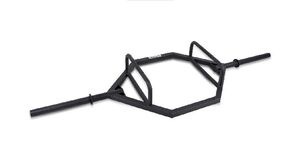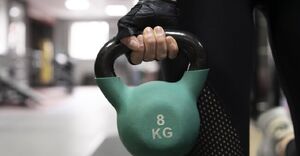
Navigating Kettlebell Weights: How to Upgrade as Your Strength Grows
Are you looking to level up your workout routine with kettlebell weights, but not sure where to start?
In this comprehensive guide, we will explore the different types of kettlebell weights, how to choose the right weight for your fitness level and goals, and the benefits of increasing kettlebell weight.
We will also discuss how often you should increase weight, and provide tips for safely progressing to heavier kettlebells. Get ready to take your strength training to the next level!
What Are Kettlebell Weights?
Kettlebell weights are a type of fitness equipment shaped like a cannonball with a handle. They are used for various exercises that target multiple muscle groups and improve strength and endurance.
The unique design of kettlebells, with their compact size and off-center weight distribution, provides an added challenge to traditional workouts, engaging stabilizing muscles for improved balance and coordination.
Their versatility allows for a wide range of movements, including swings, snatches, cleans, and presses, making them suitable for both strength training and cardiovascular exercises.
Incorporating kettlebell workouts into your fitness routine can help in building functional strength and endurance, promoting muscle growth while also boosting cardiovascular fitness.
These dynamic tools are an efficient way to add intensity and variety to your training regimen.
Why Are Kettlebell Weights Popular?
Kettlebell weights have gained popularity in the fitness world due to their effectiveness in providing a comprehensive workout that targets various muscle groups simultaneously, making them a versatile tool for strength training and overall fitness improvement.
- Kettlebells offer a wide range of exercise options, from traditional lifts like swings and squats to more dynamic movements such as snatches and cleans.
- The unique shape and off-center mass of kettlebells engage stabilizing muscles, enhancing functional strength and coordination.
- This makes them an excellent choice for individuals looking to intensify their workouts and improve their overall physical performance.
The compact nature of kettlebells allows for convenient storage and easy portability, enabling users to incorporate them into their exercise routines both at home and in the gym.
What Are The Different Types Of Kettlebell Weights?
- Kettlebell weights come in various types, including cast iron, vinyl-coated, and adjustable kettlebells. Each type offers unique features and benefits for different workout preferences.
- Cast iron kettlebells are known for their durability and classic design, making them a popular choice among traditional fitness enthusiasts. They are typically crafted from solid iron, providing a stable and balanced feel during exercises.
- On the other hand, vinyl-coated kettlebells are ideal for beginners or those looking for a more comfortable grip, thanks to the smooth and color-coded coating.
- Adjustable kettlebells offer versatility by allowing users to change the weight load, making them suitable for individuals seeking a customizable workout experience.
Cast Iron Kettlebells
Cast iron kettlebells are traditional in design and are favored by many gym enthusiasts for their durability and classic appearance. They provide a solid grip and are available in a wide range of weights for different fitness levels.
The durability of cast iron kettlebells makes them a reliable choice for intense workouts, ensuring they can withstand frequent and rigorous use without wearing out quickly. The comfortable grip they offer is essential for maintaining proper form during exercises, reducing the risk of slipping and aiding in smooth movements. With weight options ranging from light to heavy, these kettlebells cater to beginners and seasoned athletes alike, allowing individuals to progress in their strength training effectively. This versatility contributes to their popularity among gym-goers and fitness enthusiasts worldwide.
Vinyl Kettlebells
Vinyl kettlebells are coated with a layer of vinyl that provides a softer texture, making them ideal for beginners or those concerned about damaging floors. They are available in various colors and weights to suit different exercise needs.
The protective vinyl coating not only helps in preventing scratches and dents on floors but also adds a layer of durability to the kettlebells, making them a long-lasting investment.
Their beginner-friendly design often features comfortable handles, allowing for a secure grip during workouts. The range of vibrant colors not only adds a fun element to your fitness routine but also helps in easily distinguishing between different weights.
This makes them particularly suitable for individuals who are just starting their fitness journey and looking to gradually increase their strength.
Adjustable Kettlebells
Adjustable kettlebells offer the flexibility to change weights quickly by adding or removing weight plates. They are convenient for users who want to progress gradually in their strength training routines and minimize the need for multiple kettlebells.
The ease of weight adjustment makes these versatile kettlebells a practical choice for individuals at various fitness levels. Whether you are a beginner looking to build strength or an experienced lifter aiming to increase muscle mass, adjustable kettlebells cater to a wide range of needs. By simply adjusting the weight plates, users can tailor their workout intensity, allowing for a customized training experience. This adaptability promotes consistency in strength training programs, facilitating gradual progression and reducing the risk of plateaus.
How Do You Choose The Right Kettlebell Weight?
- Selecting the appropriate kettlebell weight involves considering factors such as your current fitness level, specific fitness goals, and comfort level with handling different weights during exercises.
Before selecting a kettlebell weight, take a moment to assess your current strength and endurance. Beginners may want to start with a lighter weight to focus on form and technique before progressing to heavier weights. Those aiming for strength training might opt for heavier weights that challenge their muscles effectively. It’s also essential to choose a weight that feels comfortable to grip and control during swings, presses, and other movements to prevent injuries and maximize performance.
Consider Your Fitness Level
When determining the suitable kettlebell weight, beginners should start with lighter weights to learn proper form and technique before progressing to heavier weights. Advanced users can challenge themselves with heavier kettlebells to further enhance their strength and endurance.
It is crucial for individuals at all fitness levels to prioritize safety and effectiveness in their kettlebell training. By starting with a weight that allows for controlled movements and proper engagement of muscles, beginners can establish a strong foundation for future progress. Focusing on mastering the foundational kettlebell exercises, such as swings and presses, before moving on to heavier weights can prevent injuries and ensure steady advancement. Advanced users, on the other hand, can benefit from progressively increasing the weight of their kettlebells to continue pushing their limits and achieving new milestones in their fitness journey.
Determine Your Goals
Establishing clear fitness goals is essential in choosing the right kettlebell weight. Whether aiming for muscle growth, strength improvement, or endurance enhancement, aligning the weight selection with your objectives is crucial for progress.
Setting specific goals helps provide a roadmap for your kettlebell training journey. By defining what you want to achieve, you can tailor your workouts to match those aspirations, leading to more focused and effective sessions. Having clear objectives allows you to track your progress and make necessary adjustments along the way.
The correlation between your goals, the kettlebell weight you choose, and your commitment to continuous improvement plays a significant role in building strength and enhancing overall fitness levels.
Take Into Account Your Comfort Level
Considering your comfort level when choosing a kettlebell weight ensures proper technique execution and reduces the risk of injuries during workouts. Opting for a weight that feels manageable and allows for correct form is essential for a safe and effective training experience.
Selecting the right kettlebell weight also impacts the efficiency of your workouts. When the weight is properly matched to your abilities, you can maximize the benefits of each exercise, leading to better results over time.
It’s crucial to prioritize safety and comfort over lifting heavier weights beyond your capacity. By focusing on gradual progression and mastering the form with a suitable weight, you not only prevent injuries but also enhance your overall performance and endurance in kettlebell training.
What Are The Benefits Of Increasing Kettlebell Weight?
Increasing the kettlebell weight in your workouts offers a range of benefits, including enhanced muscle mass development, increased strength and power, and improved endurance and cardiovascular health.
It is essential to challenge your body progressively to continue seeing results, and moving to heavier kettlebell weights is an effective way to do so. By lifting heavier kettlebells, you engage more muscle fibers, leading to greater muscle growth and improved overall strength.
This kind of progressive overload also enhances your cardiovascular fitness, as your heart and lungs work harder to support the increased demand. Over time, you will notice not only physical improvements but also a boost in confidence and mental resilience from conquering new challenges in your workouts.
Builds Muscle Mass
Gradually increasing kettlebell weight promotes muscle mass development by subjecting muscles to progressive resistance, stimulating growth and strength enhancement over time. This process supports muscle growth and definition for a more toned physique.
By challenging the muscles with heavier kettlebells, individuals can elicit a greater response from their muscle fibers, leading to micro-tears which then repair and grow stronger. These adaptations occur as a result of the body’s need to handle increased loads, ultimately contributing to muscle hypertrophy. When weight progression is implemented effectively, it allows muscles to continuously adapt, preventing plateaus and ensuring ongoing muscle development in terms of size and definition.
Increases Strength And Power
By upping the kettlebell weight incrementally, individuals can enhance their strength and power levels, gradually advancing from basic to more advanced exercises that challenge the muscles and improve overall physical performance.
This gradual increase in weight allows for the body to adapt and grow stronger over time, leading to significant improvements in muscle mass and overall physical strength.
By following a progressive overload approach in their strength training routine, individuals can ensure continuous growth and development in their physical abilities.
Transitioning from basic kettlebell exercises to more advanced movements not only keeps workouts exciting and engaging but also helps in targeting different muscle groups effectively for a well-rounded fitness regimen.
Improves Endurance And Cardiovascular Health
Progressing to heavier kettlebell weights enhances endurance and cardiovascular health by introducing a greater challenge to the muscles and cardiovascular system, leading to improved stamina, heart health, and overall fitness levels.
As individuals increase the weight of their kettlebells, they require more strength and power to execute exercises effectively, pushing their bodies to adapt and grow stronger. This challenge not only builds muscle but also elevates heart rate, enhancing cardiovascular fitness. With consistent training using heavier kettlebells, individuals can experience lower resting heart rates, improved circulation, and increased lung capacity. These cardiovascular benefits contribute to enhanced endurance, enabling individuals to sustain physical activity for longer durations without fatigue, ultimately leading to greater overall health and fitness.
How Often Should You Increase Kettlebell Weight?
Determining the frequency of increasing kettlebell weight should be based on listening to your body’s signals and following a progressive overload approach that involves gradually increasing the weight, reps, or sets over time.
It is crucial to pay attention to how your body responds to the current weight and workload. Progression in kettlebell training should be a gradual process to prevent injuries and ensure steady improvement. One effective strategy is to increase weight incrementally once you feel confident and comfortable with the current load.
Remember to adjust the number of repetitions and sets accordingly to challenge your body as you progress. This method allows for continuous development without overwhelming your muscles or risking burnout. By listening to your body’s feedback, you can tailor your workouts to optimize performance and achieve long-term strength gains.
Listen To Your Body
Monitoring your body’s response to kettlebell training is essential in deciding when to increase weight, ensuring that the challenge remains appropriate for your current fitness level and allowing for safe and effective progression in your routine.
When engaging in kettlebell workouts, it’s crucial to listen to how your body reacts to each movement. Paying attention to any discomfort or strain can help you determine if the weight you’re using is suitable for your strength and endurance. Adjusting the weight according to your personal comfort level is key to preventing injury and maintaining a sustainable exercise routine. Remember, your body knows best, so tuning into its signals will guide you towards continuous improvement and optimal fitness gains.
Follow A Progressive Overload Approach
Adopting a progressive overload approach involves systematically increasing kettlebell weight, sets, or challenge level to continuously push your muscles beyond their comfort zone, promoting strength and endurance gains over time.
This method is essential for athletes or fitness enthusiasts looking to enhance their performance and achieve their goals effectively. By gradually increasing the demands placed on the muscles, such as by adding more weight or increasing the number of sets, individuals can trigger muscle adaptation and growth. The systematic nature of progressive overload allows for measurable progress and ensures that one is consistently challenging themselves to prevent plateaus in strength development.”
What Are Some Tips For Safely Increasing Kettlebell Weight?
Ensuring a safe progression in kettlebell weight involves perfecting your form, gradually increasing weight, and incorporating rest days to allow for muscle recovery and injury prevention during your strength training journey.
It’s crucial to pay close attention to your body’s signals as you advance in weight, ensuring that you are not sacrificing form for heavier loads. By focusing on maintaining proper technique, you can minimize the risk of injury and maximize the benefits of your workout.
Remember that patience is key when it comes to increasing kettlebell weight – gradual progression is more sustainable and safer in the long run. Don’t underestimate the importance of rest days in your routine; these periods of recovery are essential for muscle repair and overall strength development.
Perfect Your Form First
Before adding more weight, focus on perfecting your kettlebell exercise form to ensure proper muscle engagement, balance, and coordination. Correcting any form errors early can prevent potential injuries and optimize workout effectiveness.
Mastering proper form in kettlebell exercises is crucial for maximizing your workout benefits. By executing movements with precise technique, you not only engage the target muscles effectively but also promote balanced muscle activation throughout your body.
Incorporating unilateral movements in your kettlebell routine helps address muscle imbalances and enhance stability. This balanced activation and coordination reduce the risk of overuse injuries and ensure that each muscle group is appropriately targeted, leading to improved overall exercise efficiency and performance gains.
Gradually Increase Weight
Incrementally increase kettlebell weight to challenge your muscles and promote gradual strength development. Slowly progressing to heavier weights allows for muscle adaptation and growth while minimizing the risk of overexertion or strain.
This systematic approach to kettlebell training not only helps in enhancing your physical capabilities but also contributes to overall muscle endurance and stability. By gradually increasing the weight, you allow your body to adapt and become stronger over time. The progressive challenges presented by heavier kettlebells encourage your muscles to grow and develop efficiently, leading to improved functional strength. This structured method also reduces the likelihood of injuries, ensuring a safe and effective training experience.
Incorporate Rest Days
Integrating rest days into your kettlebell workout schedule is crucial for muscle recovery, injury prevention, and overall performance improvement. Adequate rest allows muscles to repair and grow stronger, enhancing the effectiveness of your training routine.
When you consistently push your body through intense kettlebell workouts, it’s easy to overlook the importance of taking a break. Rest days are not a luxury but a necessity to help you achieve your fitness goals.
By giving your muscles time to recuperate, you reduce the risk of overuse injuries and burnout, enabling you to train more effectively in the long run. Embrace rest as an essential part of your training program, and watch how it leads to lasting performance gains over time.




No Comments